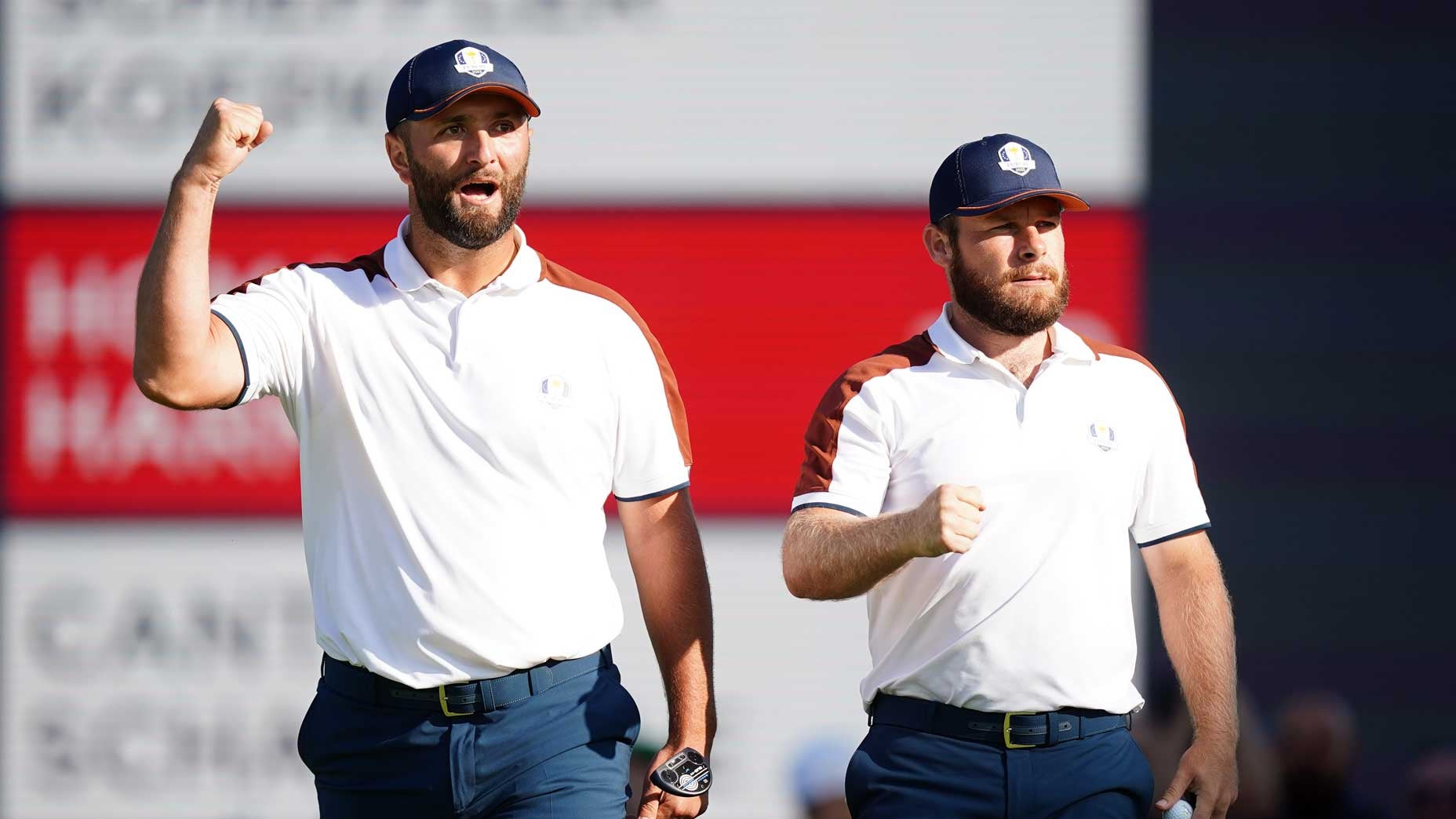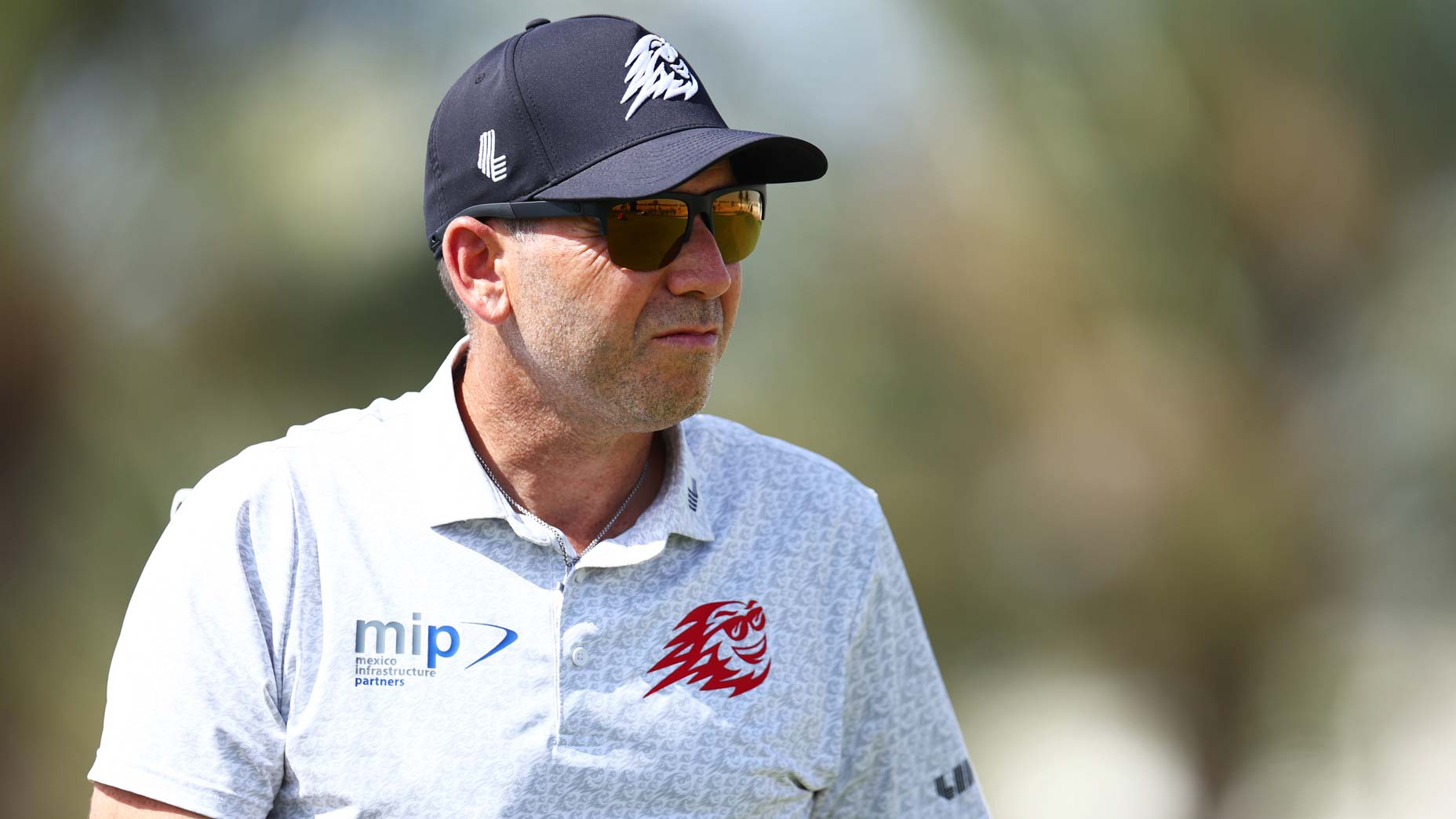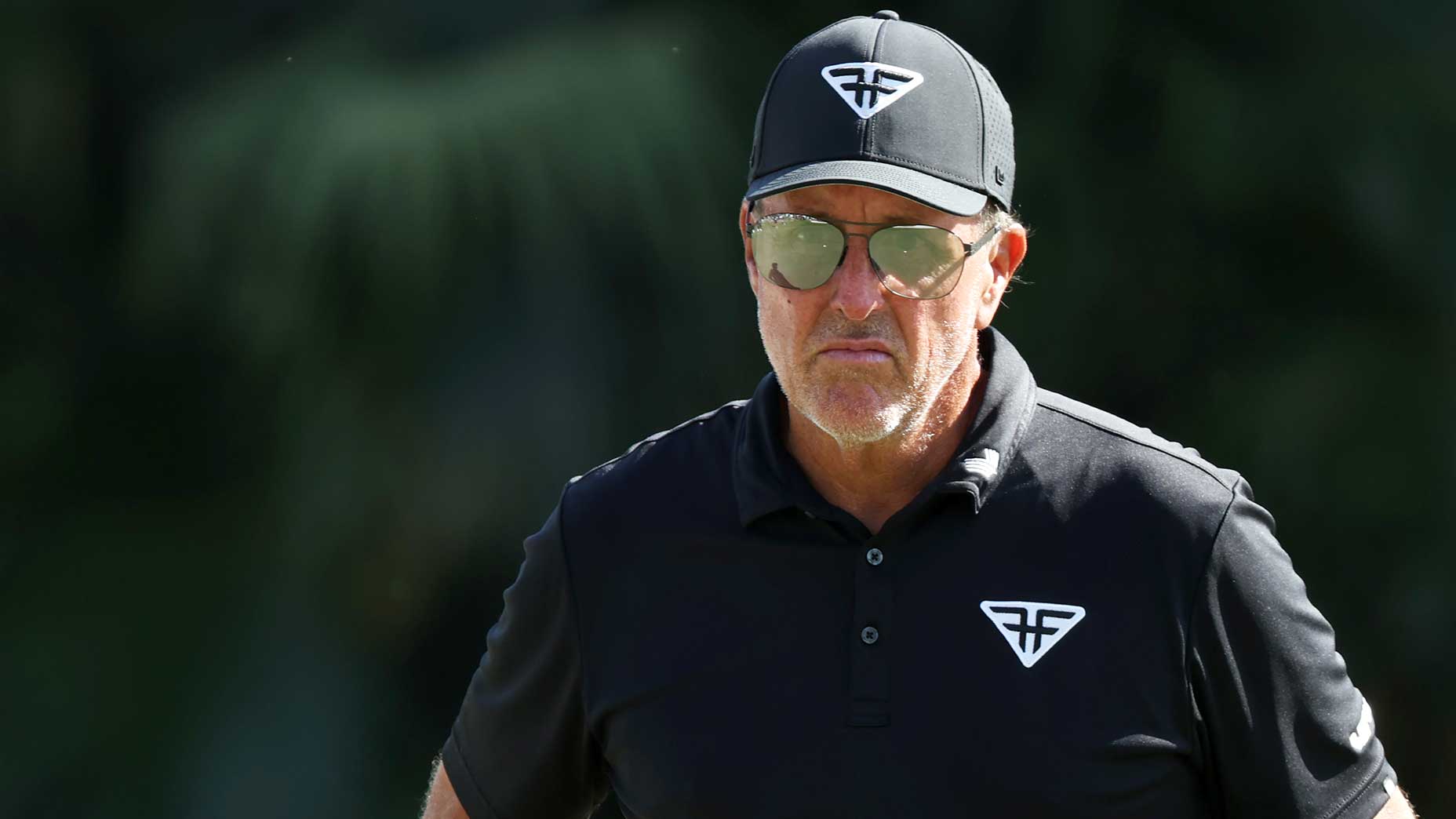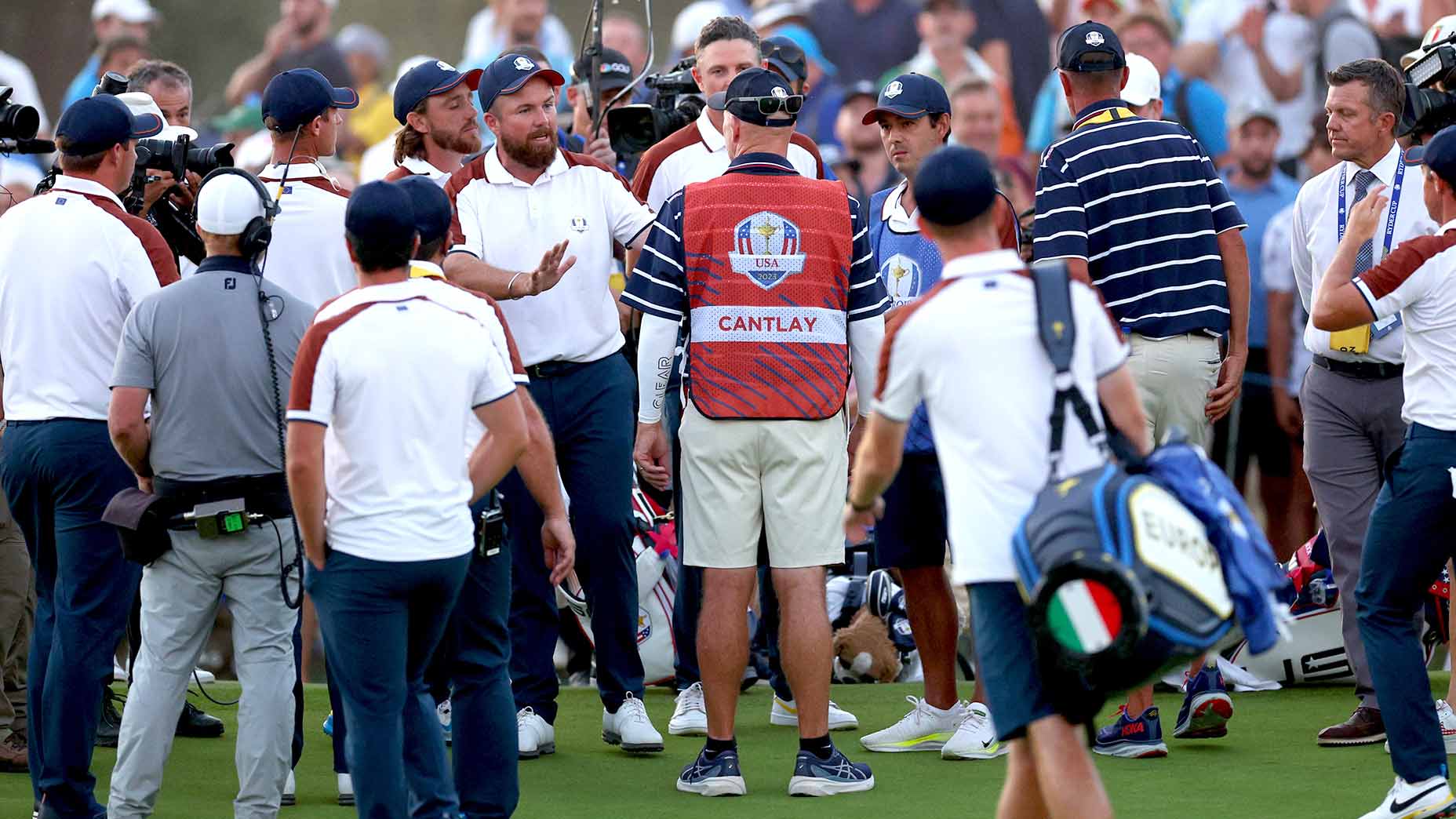‘Maybe you should ask Jordan’: The 17 most controversial moments in Ryder Cup history
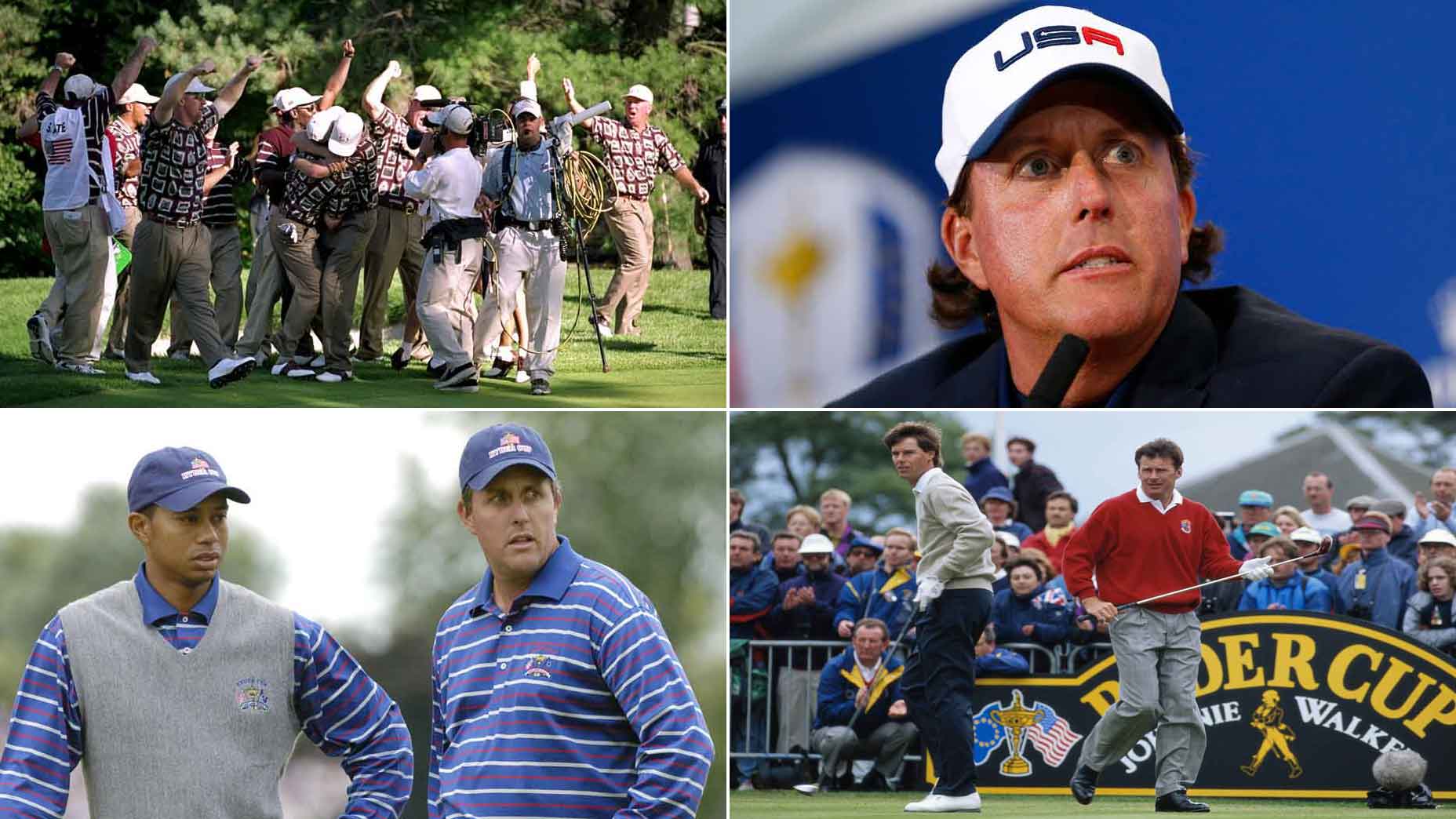
As another Ryder Cup approaches, here’s a look at 17 of the most controversial moments in the history of the biennial event.
Getty Images
Since its birth in 1927, the Ryder Cup has been a sparkling exhibition of great shotmaking and good fellowship — except for that icy presentation by Ben Hogan. And those harsh New England hecklers. And the bad blood between Paul Azinger and Seve Ballesteros. And a couple of occasions when guys took swipes at teammates or criticized their captains. And don’t even get us started on that weirdness in France involving Patrick Reed, or all that agonizing over LIV. You get the drift.
Every now and then, things have gotten testy. As another Ryder Cup approaches, here’s a look at 17 of the most controversial moments in the history of the biennial event.
(This is an updated version of an article that first ran on GOLF.com in Sept. 2021)
STICKING IT TO THE YANKS: MOORTOWN GOLF COURSE IN 1929
Talk about giving the others guys the shaft. By 1929, the USGA had approved the use of steel shafts in competition. But the R&A had yet to do so. So, when the Americans showed up on English soil steeled, as it were, for battle, their opponents made it clear: steel-shafted clubs were a no-no. The Americans went back to their old equipment, and Great Britain went on to victory.
GETTING IN THE GROOVES: PORTLAND GOLF COURSE IN 1947
Compared to some of the testy exchanges we hear about today, this one comes off as quaint. Rest assured, though, playing captain Ben Hogan and his team were far from pleased when Great Britain captain Henry Cotton called for an inspection of the grooves on the irons used by the opposition. This was just before the competition started. By the time it ended, the Americans had delivered an 11-1 whooping. Oh, and their grooves were deemed legal.
THE ICE MAN NUMBETH: CHAMPIONS GOLF COURSE IN 1967
It was the British who dubbed Ben Hogan the Wee Ice Mon, so they knew he could be chilly. And boy was he ever at a gala dinner for the two teams before the event. Having listened to British captain Dai Rees describe the strengths of his team in painstaking detail during a long introductory speech, Hogan kept his own words brief and frosty. He listed his roster in alphabetical order, and then concluded: “The United States Ryder Cup team, the finest golfers in the world.” Brrrrrrr!
SEVE AND ‘ZINGER: THE BELFRY IN 1989
Tight match, high tensions. In a Sunday singles clash between two of the fiercest competitors in Ryder Cup history, things got testy early when Azinger (successfully) disputed Seve’s request to take a scuffed ball out of play. And the air grew thicker still on the 18th hole, when Seve put forth a protest of his own, questioning whether his opponent had dropped properly from a water hazard. Azinger went on to win the match, but Seve’s team went on to win the Cup. No love was lost between the two.
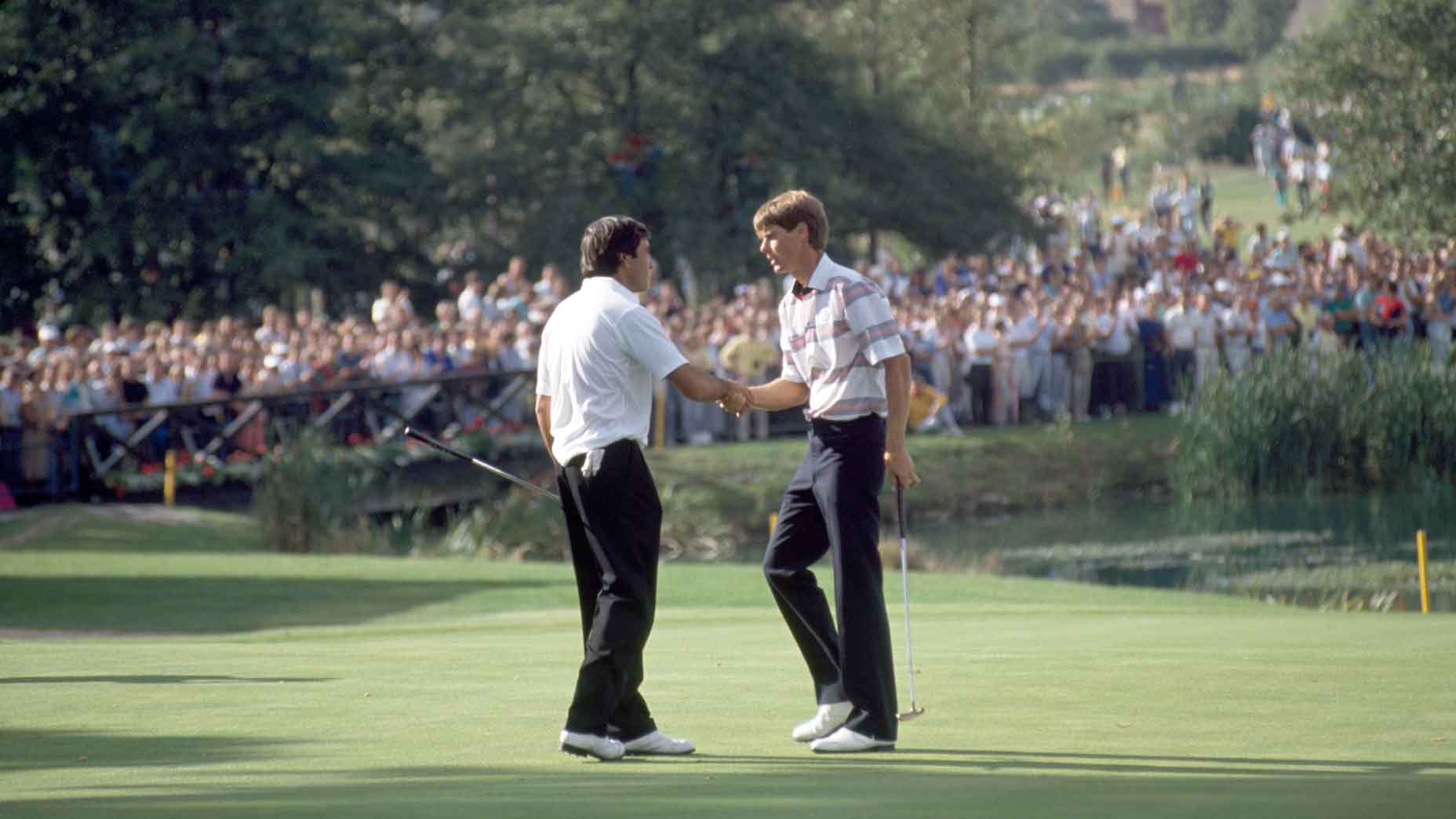
TEARS IN THE OCEAN: THE OCEAN COURSE IN 1991
In a Cup memorialized as “The War by the Shore,” the Americans showed their military mindset early by cloaking themselves in camouflage for a team photo. Then came the competition, which played out as a pitched battle, with bloodless volleys fired back and forth. Azinger and Ballesteros got into it enough to show the world that they weren’t the best of buddies. And the raucousness of the home crowd (unruliness in the eyes of many Europeans) added to a gladiatorial atmosphere. In the end, the Americans won when Bernhard Langer missed a par putt in his deciding match against Hale Irwin. But both sides had their share of walking wounded, including Mark Calcavecchia, who was 4 up with four to play in his singles match with Colin Montgomerie but stumbled badly, wound up with a halve and was seen, not long after, crying by his lonesome on the beach.
NICK FALDO VS. PAUL AZINGER: THE BELFRY IN 1993
A rivalry born at the 1987 British Open at Muirfield, where Faldo bested Azinger by a single stroke, took on a fiery new dimension at the Belfry, where the two men met in the final singles match on Sunday. Both were at their steely best. After Faldo aced the par-3 14th to go 1 up, Azinger responded with a birdie on the next. But Faldo had regained a 1-up lead as the match moved to the 18th green. Faldo made par, leaving Azinger with a six-foot birdie bid for the halve. Though team USA had already clinched the Cup, Faldo declined to concede the putt. Azinger drained it. Not long after, he would begin treatment for melanoma, which he survived, competitive spirit intact. “Look at that,” he would say, two years later, while reviewing tape of his singles match with Faldo. “I had cancer and he still couldn’t beat me.”

PAY TO PLAY? THE COUNTRY CLUB IN 1999
On the deciding Sunday, David Duval played a role in what many recall as a heroic American comeback. But prior to the event, he and teammates Tiger Woods, Phil Mickelson and Mark O’Meara were widely cast as villains. Or, at least, as bloodless mercenaries. Their offense: reportedly griping about Ryder Cup players not getting paid. “It burns the hell out of me to hear some of their viewpoints,” U.S. captain Ben Crenshaw said. Tom Lehman added: “I think we should all be ashamed. The last thing the tour needs is a bunch of greedy, wimpy, whiny brats.” As public furor rose, the four stars at the center of the storm took pains to calm it through clarification. What they wanted, they said, wasn’t money for themselves, but compensation that could be put toward their favorite charities. In the end, that’s what they got. But not before paying a public-relations price.
THE STAMPEDE: THE COUNTRY CLUB IN 1999
A day that began with an egregious fashion faux pas by Team USA (ugliest uniforms in the history of the event?) ended with an even more sensational offense. Having scratched back from 4 down to all square in his singles match against Jose Maria Olazabal, Justin Leonard faced a 45-foot putt birdie on the 17th green. Back went his blade, and off rolled his ball, over a swale and into the cup, a birdie bomb that triggered a stampede of American players and their wives (as well as TV cameramen) onto the green — all before Olazabal had a chance to attempt his own putt to extend the match. In the wake of the euphoria, the Europeans put on their own demonstration. They made it pretty clear they were aghast.
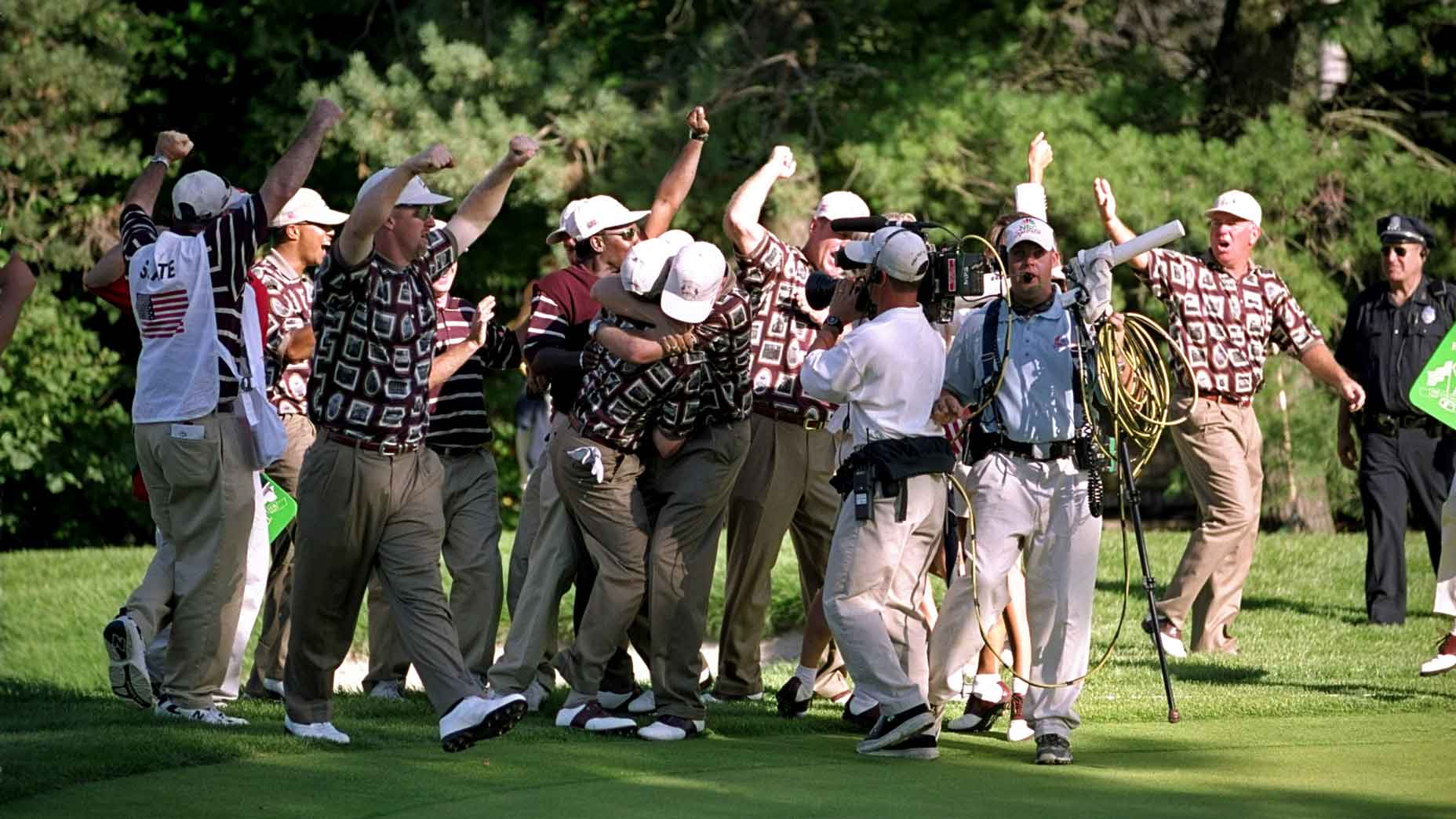
MONTY AND THE MADNESS: THE COUNTRY CLUB IN 1999
In addition to its fervent fans, Brookline is remembered for the superb, defiant play of a heckled, red-faced Colin Montgomerie. The stalwart Scot was known for having rabbit ears, but he hardly had to cup them to hear some of the insults hurled his way. (“Hey, Mrs. Doubtfire!” was one of the kinder put-downs.) It was a volatile dynamic. The more Monty reacted, the more harshly he was treated (at one point, a fan reportedly spat in the Scotsman’s face) — and the better he seemed to play. For some in the crowd, it was too much to watch, among them Monty’s father, who left the grounds appalled at the hostility. As Davis Love III noted afterwards, American players had endured their share of insults while competing for the Cup on European soil. But not everyone was so sanguine in their assessment. Consider the perspective of the famed British broadcaster Alistair Cooke, who recounted the details of the event in a Letter from America entitled “The Arrival of the Golf Hooligan.”
CATCHING HAL: OAKLAND HILLS COUNTRY CLUB IN 2004
Hindsight is 20/20. And its eyes gazed disapprovingly at U.S. captain Hal Sutton, who caught after-the-fact flack for his decision to pair Phil Mickelson and Tiger Woods in both matches on Friday. The duo came away with exactly zero points. To Sutton’s critics, the captain should have seen that the partnership was doomed from the beginning, since the two stars, for all their celebrated talent, were also famous for not getting along. As time wore on, Phil and Tiger forged something of a friendship. But Sutton’s decision proved a stubborn source of friction, sparking headlines more than a decade later as another Ryder Cup approached (more on that below).
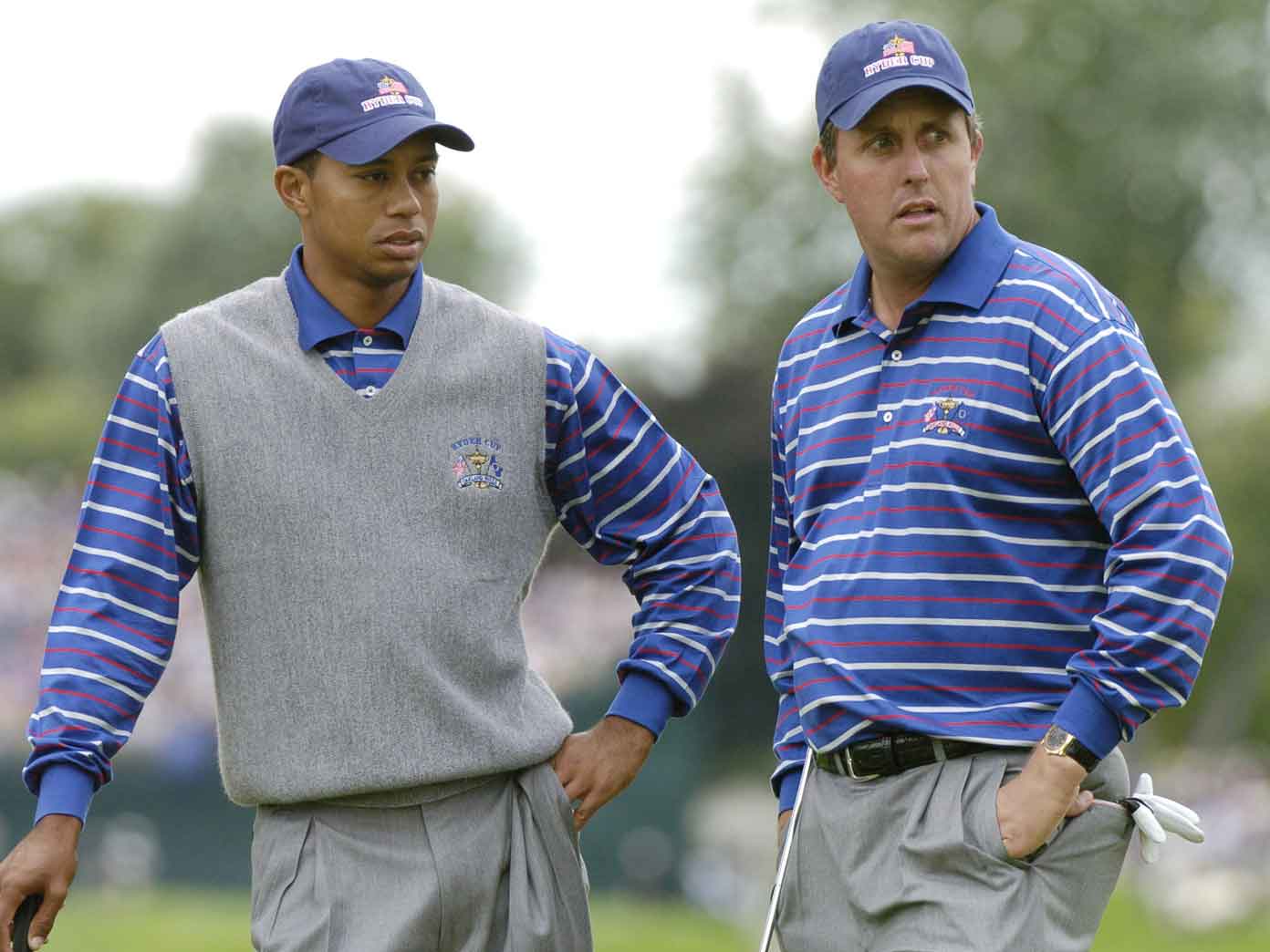
“YOU CALL THAT A NORMAL STANCE?” VALHALLA IN 2008
Afterwards, Anthony Kim insisted that he had not been irked by what looked like gamesmanship by Sergio Garcia. But in the heat of the moment, the young American sure seemed peeved. It happened on the sixth hole of their Sunday singles match, where Garcia’s drive missed wide right and wound up in thick spinach. In petitioning for relief, the Spaniard argued that his stance was impeded by a set of stone steps behind him. As Garcia stood over his ball to demonstrate his point to a referee, Kim strode over and inquired unhappily: “You call that a normal stance?”
QUIET, PLEASE! GLENEAGLES IN 2014
Fans on this side of the pond had long hoped for the modern-day emergence of an American Ian Poulter, a pesky and demonstrative competitor capable of winning points while getting under the opposition’s skin. Patrick Reed fit the bill. At Gleneagles, Reed established his thorn-in-the-side credentials, not just with what he did, but with how he did it. On his way to posting a 3-0-1 record for the week (a performance punctuated by a 1-up win in singles over Henrik Stenson) Reed proved to be an irritating presence. When spectators around the first tee exhorted him to dance (something they did to all the players) Reed declined and was roundly booed. No matter. Reed went on to quiet the crowd with clutch shotmaking and dead-eye putting — and, more annoying still, by shushing them on the seventh hole with a finger pressed to his pursed lips.
WATSON, COME HERE. HE’S DISSING YOU: GLENEAGLES IN 2014
In what amounted to an ‘ok, boomer’ moment following a third straight U.S. loss, Phil Mickelson lamented, before the gathered press, that the Americans had “strayed from a winning formula,” employed at Valhalla in 2008. Though Mickelson didn’t name names, his diagnosis of the most recent defeat (players weren’t given a voice in key decisions) made plain his discontent with U.S. captain Tom Watson. Asked if he thought that Phil was “being disloyal,” Watson shrugged off the suggestion. “Not at all. He has a difference of opinion.” An opinion that helped give rise to the Ryder Cup “task force,” along with other changes to the way the U.S. roster is selected.
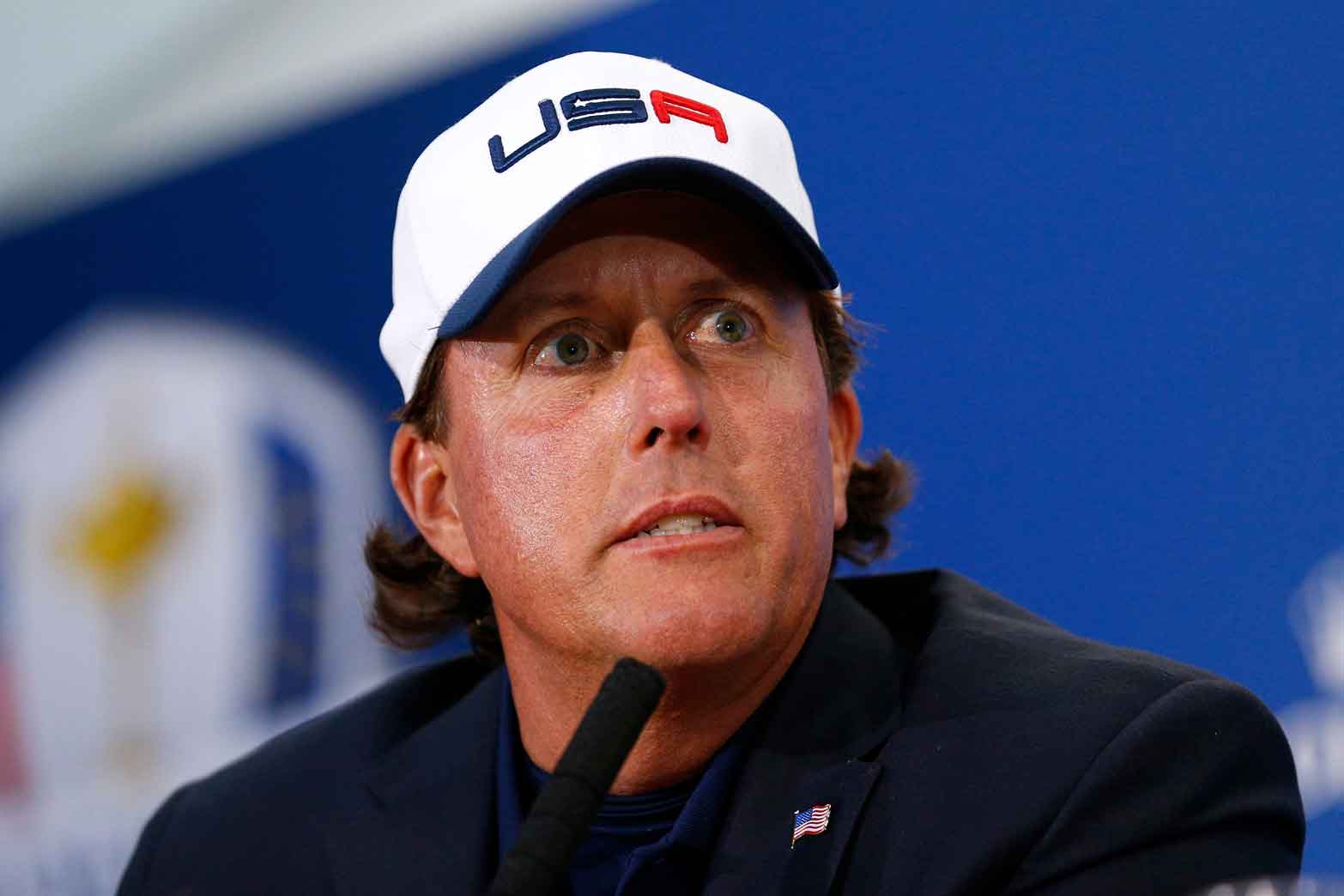
STILL CATCHING HAL: HAZELTINE IN 2016
It was the week of the 2016 Ryder Cup, but given the topic of conversation, it might as well have been 2004. “It all starts with the captain,” said Phil Mickelson, who proceeded to reflect on his ill-fated pairing with Tiger Woods 12 years before. “We were told two days before that we were playing together,” Mickelson said of then-captain Hal Sutton’s decision. “And that gave us no time to work together and prepare.” Time may heal all wounds, but Mickelson’s words opened them for Sutton. “If I still need to shoulder the blame for Phil’s poor play, then I’ll do that,” Sutton said. It wasn’t long before Lefty apologized. “I was totally in the wrong,” Mickelson said. “I never should have brought that up. I used an extreme example of the way pairings can affect play, and I never should have done that, because it affected Hal.”
L’AFFAIRE REED: LE GOLF NATIONAL IN 2018
A losing week outside Paris proved trés bizarre for the U.S. squad, and not just because it ended with reports that former workout buddies Dustin Johnson and Brooks Koepka had nearly come to blows in the European team room. It began before that, on Sunday morning, with rumblings surrounding Monsieur Patrick Reed. The Marvel hero of past Ryder Cups had been benched on both Friday and Saturday afternoon, each time following morning losses. That Captain America had failed to earn a point in partner play was surprising enough. Even more eyebrow-raising was that he had played with Tiger Woods instead of Jordan Spieth, his trusted sidekick in prior (triumphant) Ryder Cup showings. Captain Jim Furyk had opted to break up the duo. Why? The Twittersphere was wondering, and on Sunday morning, Reed’s wife, Justine, weighed in. “Patrick never said that he didn’t want to play with Jordan. Maybe you should ask Jordan why he didn’t want to play with Patrick,” one of her tweets read. At a press conference Sunday evening, the question went to directly to Reed and Spieth: were they surprised that they’d been split up? The two men glanced at each other before Spieth offered: “We were totally involved with every decision that was made.” Reed sat quietly, smiling in Spieth’s direction. But later that evening, he opened up in an interview with The New York Times. “The issue is obviously with Jordan not wanting to play with me,” Reed said, adding that whether he liked his partner or his partner liked him didn’t matter to him so long as they won. Reed also questioned Furyk’s wisdom. “For somebody as successful in the Ryder Cup as I am, I don’t think it’s smart to sit me twice.”
GIMME THAT: WHISTLING STRAITS, 2021
The circle of friendship? Seemed more like the radius of resentment on Saturday morning in Wisconsin when Patrick Cantlay and Xander Schauffele, playing a foursome match against Matt Fitzpatrick and Lee Westwood, failed to concede an 18-inch putt to Westwood on the sixth hole. Though Westwood didn’t grouse aloud, he bore the sour look of a man who’d eaten a bad cheese curd as he stepped up and tapped in. Moments later, on the eighth hole, cameras captured an indignant Justin Thomas (paired with Jordan Spieth), laying his putter on the ground beside the cup, his passive-aggressive way of telling Bernd Wiesberger and Viktor Hovland that the shortie he’d just made was “inside the leather.” And the aggrieved theatrics weren’t over. Before the matches ended, Bryson DeChambeau and Shane Lowry had both joined the act. At which point, many fans were pleading for a different kind of gimme: as in, quit the whining and give us all a break.
LIVID OVER LIV: MARCO SIMONE GOLF CLUB, 2023
After nearly a century of periodic petulance and petty squabbles, the Ryder Cup was swept up in the biggest golf controversy of all time. Though a peace accord had since been signed, golf’s civil war between LIV and the established tours ripped through the game, testing allegiances, straining organizations and forever altering the Ryder Cup. As punishment for his switch to LIV, Henrik Stenson was stripped of his team captaincy and replaced by Luke Donald. Lee Westwood, Ian Poulter and Sergio Garcia all resigned their DP World Tour memberships, losing any fleeting chance they might have had to etch their names one last time in Ryder Cup lore. State-side, there was outrage over LIV and arguments over whether Americans who’d left the Tour should even considered for Team USA. As it stands, only one LIV player — Brooks Koepka — found a road to Rome. Whether more will follow in the future is difficult to say. For now, though, absences are being felt in both direction. “It’s a little strange not having them around,” Rory McIlroy said on Wednesday. “But I think this week of all weeks it is going to hit home with them that they are not here, and I think they’re going to miss being here more than we’re missing them.”



